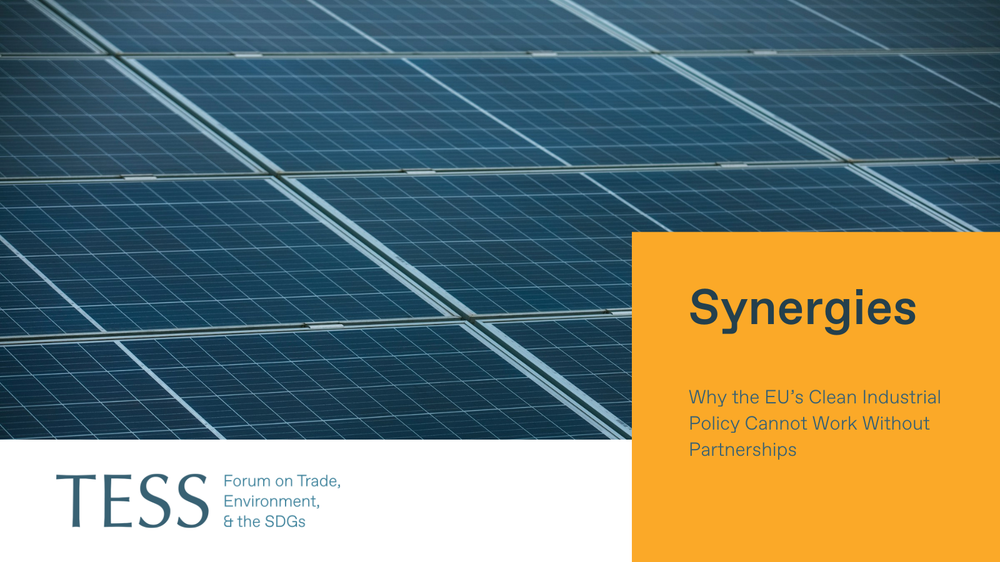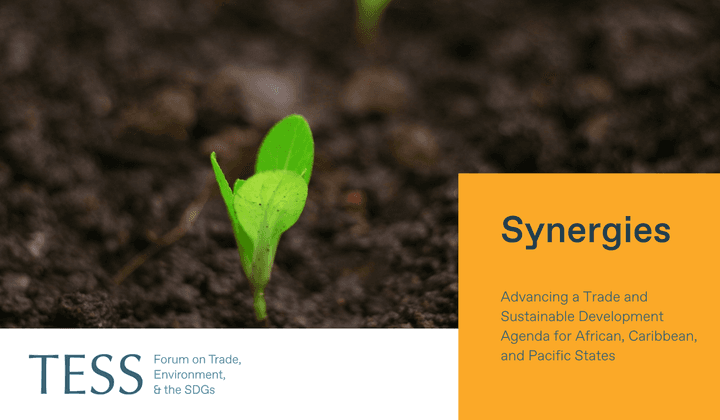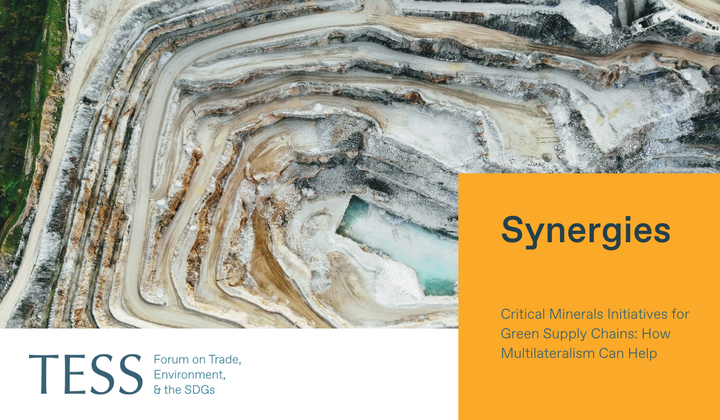As the EU gears up to safeguard its competitiveness and resilience, including through Clean Trade and Investment Partnerships, the risk of turning inward at the expense of partnerships and climate diplomacy should not be underestimated.
This article is part of a Synergies series on climate and trade curated by TESS titled Addressing the Climate Crisis and Supporting Climate-Resilient Development: Where Can the Trading System Contribute? Any views and opinions expressed are those of the author(s) and do not necessarily reflect those of TESS or any of its partner organizations or funders.
-----

Sparked by the US Inflation Reduction Act and following decades of strategic investments in clean tech industries by China, clean industrial policy is now at the centre of the European Union’s climate and economic strategy. With the EU Clean Industrial Deal, Brussels aims to secure a clean industrial base, scale up manufacturing of clean technology, and strengthen supply chain security in response to shifting geopolitical dynamics. But while the EU gears up to safeguard its own competitiveness and resilience, the risk of turning inward, at the expense of partnerships and climate diplomacy, should not be underestimated.
The EU cannot decarbonize alone. It needs critical raw materials, clean tech, and clean energy, some of which will need to come from outside its borders. Meanwhile, many countries, from Chile to Namibia and Brazil, are pursuing their own green industrial strategies. Others, especially those with limited fiscal space and high vulnerability to climate impacts, may fall behind rich countries in a world of heavily subsidized green industrial policies. That is where the EU’s Clean Trade and Investment Partnerships (CTIPs) come in.
Clean industrial policy is now at the centre of the European Union’s climate and economic strategy.
From Fragmentation to Coordination
The CTIPs mark a shift in how the EU approaches partnerships. Announced as part of the external dimension of the Clean Industrial Deal in February, they aim to “foster cooperation on energy technology and policies for the clean transition, and support decarbonisation efforts in partner countries.” More pointedly, they aim to secure reliable access to critical raw materials, clean energy, and clean tech.
This is a welcome recognition that the EU’s web of partnership offerings has often been fragmented, incoherent, and difficult to navigate for partner countries. In recent years, various parts of the European Commission pursued their own partnership agendas: Directorate-General (DG) GROW launched Strategic Partnerships on Critical Raw Materials; DG CLIMA signed Green Alliances; DG TRADE integrated climate clauses into free trade agreements; and DG INTPA advanced Global Gateway projects, in addition to the Just Energy Transition Partnerships—all often with little coordination. As a diplomat from a partner country once quipped: “The Chinese give us an offer we can’t refuse. The EU gives us an offer we can’t understand.”
CTIPs aim to address past shortcomings and offer a more integrated and strategic approach aligned with European and partner country priorities. But turning this vision into impact will require more than relabelling existing initiatives or combining fragmented tools.
The Clean Trade and Investment Partnerships aim to offer a more integrated and strategic approach aligned with European and partner country priorities.
Ensuring Success for the First CTIP With South Africa
The EU launched the first CTIP with South Africa in March 2025, less than one month after the release of the Clean Industrial Deal. The announcement was linked to the launch of a Global Gateway Investment Package worth €4.7 billion, including €303 million in EU grants and loans from EU institutions and development banks. This aims to support South Africa’s just transition and clean industry build-out, particularly on green hydrogen, critical raw material processing, renewables and clean tech jobs. The package also includes investments in connectivity infrastructure and strengthening vaccine production in South Africa.
For the CTIP to succeed and to set a precedent for future partnerships, it must start with four critical shifts, grounded in key principles and learnings from past missteps:
- The CTIP must reflect shared priorities, not just the EU’s supply needs for the clean transition. Europe can learn from previous mistakes from its extractive foreign policy that reduced partners to mere raw material exporters and instead invest in a more equitable approach that supports South Africa’s own industrial and socio-economic development goals. The CTIP should help build green value chains in South Africa, not just to Europe, through local processing, refining, and manufacturing, alongside skills training and workforce development.
- The EU can establish structured and inclusive stakeholder dialogues, both in partner countries and within Europe to reinforce buy-in. Civil society, trade unions, the private sector, investors, and local industry must be involved from the start. A DG Trade Civil Society Dialogue on CTIPs, modelled on those used in trade negotiations, could offer transparency and trust-building, which are key ingredients for long-term cooperation to avoid a short-term vision.
- To be credible, the CTIPs must come with new and real resources, not recycled announcements or rebranded projects. That includes investments in sustainable trade infrastructure (e.g. port upgrades) and co-development of standards on clean supply chains, among other priorities. Additionally, the EU can support the facilitation of private investments through giving confidence to European investors, for example through offtake agreements.
- Coordination is essential. The CTIP must have high-level political leadership and coherence across European Commission DGs and member states to learn from past mistakes with partnerships. A Team Europe approach means aligning bilateral deals with collective EU priorities and clearly linking CTIPs to tools like clean procurement, industrial incentives, and trade policy.
The Way Forward for CTIPs: Balancing Building Trust and Speed
One advantage of CTIPs is that they are not constrained by the lengthy timelines of free trade agreements. But rushing to announce new partnerships without delivering on existing ones risks damaging credibility. The EU must strike a balance: move fast enough to stay relevant, but deep enough to build trust.
Equally, the EU must be honest about the political economy of green industrialization. The CTIPs must work not only diplomatically, but also commercially, creating a framework that gives European and partner country businesses the confidence to invest. The EU can help address bottlenecks seen in other critical raw materials partnerships, such as the lack of EU mining companies willing to invest in partner countries where the political conditions were in place but the private sector was not present.
If the EU gets it right, it can help set a new global standard for how trade, investment, and decarbonization can work together and secure new partners.
Perhaps most importantly, the EU must lead by example. The credibility of its external partnerships hinge on the integrity of its internal transition and targets. Its 2040 climate target needs to be built on real emissions cuts, not international offsetting. Moreover, to maintain trust, the EU can put diplomatic support behind the New Collective Quantified Goal on Climate Finance pathway.
If the EU gets it right, it won’t just accelerate its own transition, it can help set a new global standard for how trade, investment, and decarbonization can work together and secure new partners.
----------
Sarah Jackson is Climate Policy Analyst at the NewClimate Institute.
-----
Synergies by TESS is a blog dedicated to promoting inclusive policy dialogue at the intersection of trade, environment, and sustainable development, drawing on perspectives from a range of experts from around the globe. The editor is Fabrice Lehmann.
Disclaimer
Any views and opinions expressed on Synergies are those of the author(s) and do not necessarily reflect those of TESS or any of its partner organizations or funders.
License
All of the content on Synergies is licensed under a Creative Commons Attribution-NonCommercial-ShareAlike 4.0 International (CC BY-NC-SA 4.0)
license. This means you are welcome to adapt, copy, and share it on your
platforms with attribution to the source and author(s), but not for
commercial purposes. You must also share it under the same CC BY-NC-SA
4.0 license.
If you would like to reuse any material published here or if you have any other question related to Synergies, send an email to fabrice.lehmann@graduateinstitute.ch.




